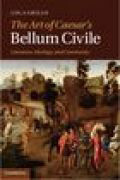
The art of caesar's bellum civile: literature, ideology, and community
Grillo, Luca
Comprehensive exploration of the artistic properties and intellectual complexity of Caesar's Bellum Civile, showing the interaction of literature and politics. Participating in a new wave of Caesar studies, this book examines the Bellum Civile as a piece of literature written by a recognized intellectual andnot simply a successful politician and general. Focusing on the peculiaritiesof Caesar's art, this reading explores the work's style, rhetoric, ideology and architecture. Participating in a new wave of Caesar studies, this book examines the Bellum Civile as a piece of literature written by a recognized intellectual and not simply a successful politician and general. Focusing on the peculiarities of Caesar's art, this reading explores the work's style, rhetoric, ideology and architecture. Traditional approaches have reduced Caesar's BellumCivile to a tool for teaching Latin or to one-dimensional propaganda, therebyunderestimating its artistic properties and ideological complexity. Reading strategies typical of scholarship on Latin poetry, like intertextuality, narratology, semantic, rhetorical and structural analysis, cast a new light on the Bellum Civile: Ciceronian language advances Caesar's claim to represent Rome; technical vocabulary reinforces the ethical division between 'us' and the 'barbarian' enemy; switches of focalization guide our perception of the narrative; invective and characterization exclude the Pompeians from the Roman community,according to the mechanisms of rhetoric; and the very structure of the work promotes Caesar's cause. As a piece of literature interacting with its culturaland socio-political world, the Bellum Civile participates in Caesar's multimedia campaign of self-fashioning. A comprehensive approach, such as has been productively applied to Augustus' program, locates the Bellum Civile at the interplay between literature, images and politics. INDICE: Introduction. Between ancient and modern approaches: admirers and detractors of Caesar; 1. The swift and the slow: Caesar's art of characterization; 2. The great contest: constantia, innocentia, pudor, and virtus; 3. Redefining loyalty; 4. The limits and risks of Caesar's leniency; 5. The barbarization of the enemy; 6. Two army-communities and their effect on the Roman people; 7. Shaping the future of Rome: the architecture of the Bellum Civile; Appendix 1. Chronology of the Civil War (pre-Julian calendar) and narrative structure of the Bellum Civile; Appendix 2. Composition, publication and genre of the Bellum Civile; Appendix 3. The manuscript tradition of the Bellum Civile. Opening, end and book division.
- ISBN: 978-1-107-00949-3
- Editorial: Cambridge University
- Encuadernacion: Cartoné
- Páginas: 234
- Fecha Publicación: 19/01/2012
- Nº Volúmenes: 1
- Idioma: Inglés
